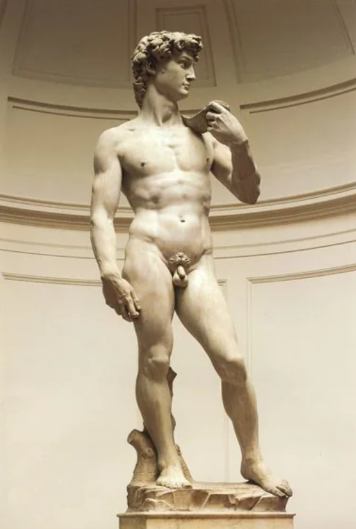
Michelangelo’s sculpture “David” is the pinnacle of the humanistic spirit of the Renaissance, and is also the ultimate interpretation of the aesthetics of the human body in Western classical art. This 5.17-meter-high marble statue not only demonstrates the inheritance and transcendence of ancient Greek and Roman art, but also reveals the philosophical pursuit of “perfect humanity” in the Renaissance through its unique artistic language. The following is an in-depth analysis from multiple dimensions:
- The perfect fusion of anatomy and dynamic balance
- Reconstruction of Contrapposto (opposing balance)
Michelangelo broke through the classic proportions of the ancient Greek sculptor Polykleitos’ “Spear Bearer”, placing the center of gravity of the human body on the right leg, with the left leg slightly bent and the spine twisted in an S shape. This asymmetrical dynamic not only implies the instantaneous tension before the battle, but also creates a dramatic sense of readiness through the precise depiction of muscle fibers (such as the contrast between the bulge of the right arm vein and the relaxation of the left arm).
- Surreal anatomical exaggeration
David’s right hand is slightly larger than a normal human body (the length of the palm is 1/10 of the height instead of 1/12), and the pupil is carved into a heart shape to enhance the penetrating power of the gaze. This “idealized distortion” is not a technical error, but a visual compensation principle (viewer’s perspective correction) to ensure the sense of coordination when looking up, reflecting the artist’s precise control of the viewer’s psychology. - Three-dimensional declaration of humanistic aesthetics
- Dialectical unity of divinity and humanity
Unlike the feminine boy image of Donatello’s bronze “David”, Michelangelo created an adult hero who is about to go into battle. The tight neck muscles and slightly frowned brows condense the control of human reason over destiny, while the deliberately weakened genital size (15% smaller than ancient Greek sculptures) sublimates desire into spiritual power, echoing the Neoplatonic idea that “the body is a cage for the soul”. - Philosophical metaphor of unfinishedness
The base of the statue retains some rough raw stones, which forms a sharp contrast with the polished body. This “non-finality” (Non-Finito) technique alludes to the process of human beings breaking free from chaotic matter and climbing to divine reason, which echoes the “awakening human body” used by Michelangelo in the sculpture of the Medici family mausoleum.
III. The game between political symbols and spatial power
- The material totem of republicanism
The “David” originally planned to be placed on the top of the Florence Cathedral was finally accommodated in the Piazza della Signoria in front of the City Hall (now the Old Palace). This spatial displacement transformed it from a religious context into a symbol of civic spirit. The slingshot (unfinished carving) in the right hand and the loose shoulder strap in the left hand imply the defense of the city-state’s freedom with wisdom (David versus Goliath) rather than brute force. - Subversive design of staring at power
The statue’s eyes turn slightly to the left, and the line of sight points over the viewer’s head towards Rome. This deliberately created “transcendent gaze” is not only a silent challenge to the authority of the Church, but also a dialogue between public sculpture and urban space – new muscle tension rhythms can be found from every viewing angle.
IV. The paradigm revolution of Renaissance aesthetics
- Victory of material will
Michelangelo abandoned the bronze gilding technique popular at the time and chose the original texture of Carrara marble. Through “subtractive sculpture” (Sottrazione), stone defects (cracks and spots in the original stone) were transformed into dynamic advantages, such as the incomplete peeling of the stone behind the left leg to enhance the mechanical stability, and practiced his famous saying “sculpture exists in the stone, I just remove the excess part”.
- Deconstruction of the time dimension
Traditional biblical scenes mostly show the moment after David’s victory, while Michelangelo chose the critical moment before the decisive battle. The tense body is like a compressed spring, solidifying physical time in the marble, creating “eternal moment” (L’istante eterno) – this is the forerunner of Baroque dramatic aesthetics.
V. Influence of later generations and aesthetic evolution
The 18th-century neoclassicists regarded it as the criterion of “absolute beauty”, and Winckelmann praised its “noble simplicity and quiet greatness”; Rodin saw “unreleased passion” in it, and believed that its muscle lines foreshadowed the painful distortion in “The Gates of Hell”. This change in interpretation reflects the shift of Western aesthetics from rational worship to existential anxiety.
Contemporary neuroaesthetic research shows that when viewers gaze at the statue of David, the brain’s reward circuit (Ventral Striatum) and the default mode network (Default Mode Network) will be activated synchronously, confirming its aesthetic universality across time and space. This sculpture ultimately transcends the artistic ontology and becomes a prism for humans to understand their own existence – both a perfect material entity and an infinite spiritual signifier.
